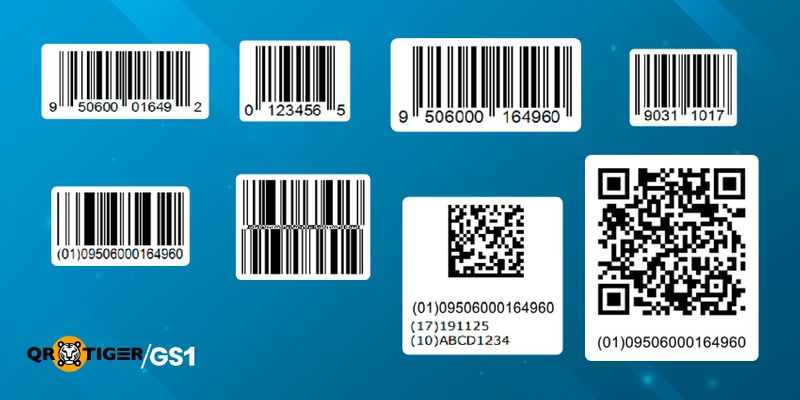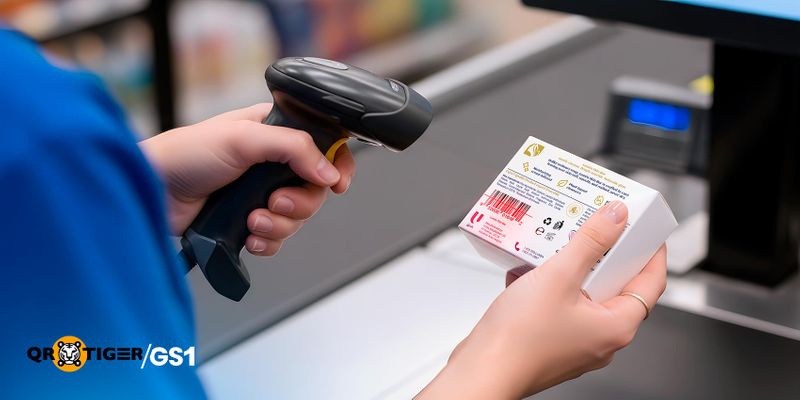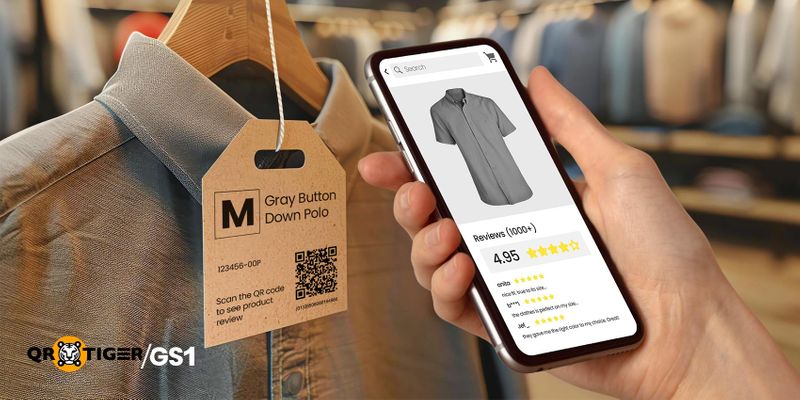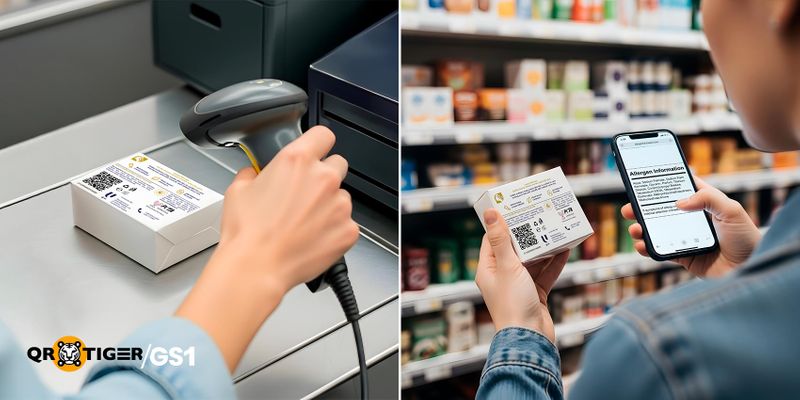The Types of GS1 Retail Barcodes Today

A GS1 Retail barcode is the familiar black-and-white symbol you see on almost every product. It’s part of the global GS1 system, which ensures products can be scanned, identified, and sold worldwide.
At its core, the retail barcode does three critical jobs:
Product identification → It connects a product to its unique Global Trade Item Number (GTIN).
Inventory management → It allows retailers to track stock levels and restock accurately.
Point of Sale (POS) → This is the most important function. Retail barcodes are designed to be scanned instantly at checkout, with the classic beep that finalizes a sale.
List of barcodes for retail and POS today
Retail barcodes may look like identical stripes, but each has its own format, purpose, and place in the checkout process. Some are everywhere, others appear only when packaging space or product type demands it.
Most common barcodes
UPC-A:The retail standard in the U.S. and Canada. It has 12 digits, representing the Global Trade Item Number (GTIN). It’s the default barcode for most products in North American stores.
EAN-13: The international standard outside North America. It has 13 digits and is accepted worldwide. This is the barcode that makes global retail possible.
Other POS Barcodes (Use-Case Specific)
UPC-E: A shortened form of UPC-A that compresses certain zeros in the manufacturer and product codes to fit into a smaller barcode. When scanned, the system automatically expands it back to the standard 12-digit GTIN. It’s often used on small products like gum, lip balm, or trial-size cosmetics.
Structure:
- Barcode symbol (machine-readable): Encodes only 6 compressed digits.
- Printed representation (human-readable): Typically shows 8 digits total — 1-digit number system (0 or 1), 6 compressed digits, and 1 check digit. The number system and check digit are printed outside the bars, not encoded directly in the bar pattern.
- Eligibility: Only UPC-A numbers with number system 0 or 1 can be converted.
Compression rules:
- Cases 0–2: Manufacturer code ends in 000, 100, or 200.
- Case 3: Manufacturer code ends in 00X (X = 3–9).
- Case 4: Manufacturer code ends in 0 followed by any 4 digits (0XXXX), and product code is 0000X (where X = the last digit)
- Cases 5–9: Product code is 0000X (X = 5–9).
EAN-8: A special, limited barcode that carries an 8-digit GTIN. Unlike EAN-13, it isn’t derived from a standard company prefix. Instead, GS1 member organizations issue them individually under a GS1-8 Prefix, reserved for products with extremely limited packaging space.
Companies must request them and demonstrate that a longer barcode simply won’t fit. Common examples include very small items like candy, cosmetics, or stationery.
GS1 DataBar Family: A group of barcodes created to carry more data than other barcode. DataBars can also encode expiration dates, batch/lot numbers, weight, and coupon information. The trade-off is size: the more data encoded, the more space the barcode takes up. Some formats are optimized for POS scanners, while others are not.
Databar usable at POS (scannable at checkout):
- Omnidirectional → Common in supermarkets for fresh produce. Reads from any angle.
- Stacked Omnidirectional → A compact version for very small packages.
- Expanded & Expanded Stacked → For coupons, fresh food, and variable-weight items. Can hold details like weight, expiration date, or lot number.
Databar not used at POS:
- Limited → Designed for very small healthcare products, not retail checkout.
- Truncated → Reduced height, but too unreliable for supermarket scanners.

Where 1D barcodes fall short
They remain reliable identifiers, but 1D or linear barcodes carry limitations that matter more in modern retail. Chief among them is the trade-off between data, size, and readability.
Limited data storage: They only encode a GTIN. Even variants like DataBar can add details (weight, dates), but at the cost of larger symbols.
Size constraints: 1D barcodes require a minimum width and quiet zones on each side. While some manufacturers truncate (shorten the height) to save space, this isn’t recommended. Truncated symbols may scan, but they’re more prone to failures at checkout.
Scanning orientation: Linear codes must be aligned with the scanner beam. If they’re printed on curved surfaces or angled incorrectly, they often struggle to read.
Durability issues → Since the data runs only in one direction, a single scratch or smudge across the bars can make the entire symbol unreadable.
2D Barcodes for POS: Why were they not used then
2D barcodes like QR codes are far superior to traditional linear barcodes. They can store far more data, a feature proven effective in automotive and healthcare since the 1990s.
So if these codes were capable, why weren’t they adopted earlier in retail? The answer lies in several real-world barriers:
No Standardized Use for 2D in Retail: When it was first invented, QR codes were used in closed-loop systems, like tracking car parts within a single factory. There was no global rule for what data should be in a retail 2D code. Without standardization, different companies could encode data differently.
Backend Systems Not Ready: Although a QR code could be scanned, warehouse and retail systems weren’t designed to process richer data. Feeding expiry dates or serial numbers into an ERP or WMS required more processing power and storage than systems of the time could handle.
Scanner Infrastructure and Cost: The global supply chain was built on laser scanners optimized for 1D patterns. These devices were cheap, lightning fast, and reliable. But they couldn’t read QR or Data Matrix codes. Switching would have meant replacing every scanner across warehouses, conveyors, distribution hubs, and checkout lanes. The costs outweighed the perceived benefits.
Lack of a Compelling Business Need: The UPC already did its one job: identifying a product type. For high-level inventory and checkout, that was enough. Adding serial numbers, expiry dates, or batch codes was seen as overkill at a time when supply chains weren’t asking for that level of detail.

Solution: GS1 Application identifiers and their syntax
The breakthrough in making 2D barcode work in retail is the GS1 Application Identifiers (AIs) and their strict syntax, which ensure that data is always in a globally understood format.
AIs are short numeric codes that act as universal labels. They define not only the type of data but also its fixed format (e.g., length, numeric vs. alphanumeric). Data cannot be in any format; it must follow the rules for its AI.
Here are samples:
01 → a 14-digit GTIN
10 → an up to 20 alphanumeric batch number
17 → a 6-digit expiry date (YYMMDD).
The same product information can be packaged in two different ways using the GS1 AI format:
1. Element String Format
This is the compact, machine-readable version used in POS and backend systems.
Example: (01)095060001649239(10)ABC123(17)250101
Note: (Parentheses () are only shown for clarity. The actual code has one continuous string.)
If a retail system is already 2D barcode compatible, the process stays the same: Scan the code, register the sale.
The POS or backend system automatically gets the GS1 data (GTIN), just as it does today with linear barcodes.
2. Web URL Format (GS1 Digital Link)
This format turns the same product data into a web address. The main benefit of the GS1 Digital Link is that smartphones can scan the same code used at checkout. Instead of sending data only to the store system, it opens a webpage connected to that product.
This way, the store still gets the right product details for sales and tracking, while customers can see helpful information such as where the product came from, how to use it, or how to recycle it, all from one 2D code.
Example: https://example.com/01/09506000164923/10/ABC123?17=250101
Sunrise 2027
The retail industry is aligning on a major milestone: all point-of-sale (POS) systems must be capable of scanning both traditional 1D and new 2D barcodes. This initiative is known as GS1 Sunrise 2027.
It’s called a sunrise rather than a sunset because nothing is being taken away. Traditional barcodes will continue to work at checkout. What’s changing is that 2D barcodes are now a viable upgrade, giving retailers and brands the option to include richer data without losing compatibility.
The push for this initiative was first introduced by GS1 in 2021 as part of its global standards strategy. What makes this a true worldwide movement is GS1’s unique role: it’s the only global standards body for barcodes, with over 115 member organizations covering nearly every country.
That means the rulebook is shared internationally, ensuring that a barcode printed in Tokyo, Toronto, or Turin will be understood the same way.
During the transition period, many products will carry two barcodes, a familiar UPC or EAN plus a new 2D symbol.
But the long-term target is clear: one barcode per package, with the 2D symbol carrying both the GTIN for checkout, additional data for business and links to information consumers need for smart purchase.
In short, Sunrise 2027 ensures that the checkout beep we all know will still work, but behind that beep, GS1 2D barcodes, eventually with just one symbol per product, will make more intelligence and flexibility possible.
Benefits of Using GS1 QR Codes in Retail

2D barcodes offer more than just scanning convenience. They bring tangible advantages for both consumers and retailers.
Richer product information without clutter: Ingredients, allergens, certifications, and other details can be accessed digitally, freeing up packaging space.
More precise inventory management: Retailers can track stock at the batch, lot, serial number, or sell-by date level, giving them sharper control over availability, freshness, and waste reduction.
Faster, targeted recalls: Encoded batch and expiry data allow problem products to be isolated without pulling everything off the shelf.
One symbol for all uses: A single barcode using the GS1 Digital link can serve both supply chain operations and consumer engagement needs.
Compliance made easier: Meets growing requirements for transparency on safety, nutrition, and sustainability.
The expanding role of retail barcodes
From the familiar UPC stripes to the smarter QR symbols of today, retail barcodes have evolved with the needs of both supply chains and shoppers. The move from linear formats to 2D barcodes doesn’t replace that role; it expands it.
One scan can now do more than ring up a sale. It can help manage expiry dates, speed up recalls, or deliver product details directly to a customer’s phone. The essence remains the same: these codes keep goods moving, but their potential impact continues to improve.

FAQ
What is the difference between 1D and 2D barcodes?
1D barcodes, like UPC or EAN, are linear codes that hold a product’s GTIN and are optimized for checkout. 2D barcodes, like QR codes, can carry much more information (expiry date, batch, serial, links). They’re also scannable from any angle and take up less space on packaging.
Is the shift from 1D to 2D mandatory?
No. Traditional 1D barcodes will continue to work, and there is no requirement to stop using them. The Sunrise 2027 initiative only sets the expectation that all retail POS systems can scan both 1D and 2D barcodes.
Brands aren’t forced to abandon UPC or EAN unless their industry has regulations that require more information that these barcodes can carry. The safest step is to confirm with your GS1 Member Organization or regulator.
Is scanning a QR code with my phone the same as scanning at checkout?
Not exactly. A consumer scanning with their phone may be taken to a product page, manual, or campaign link.
At checkout, the same barcode, which pulls the GTIN to finalize the sale. The GS1 Digital Link standard ensures the same symbol can serve both uses without conflict.
How do I start testing GS1 Digital Link QR codes on my products?
- Start with pilot projects on products where more information or consumer engagement would help. For example, fresh food (expiry dates, allergens) or branded items (recipes, care instructions, promotions).
- Remember: Most GS1 MOs do not generate 2D barcodes. They provide the standards and guidelines only.
- To create the codes, either: Develop your own software, or Use third-party services such as QR Tiger’s GS1 QR Code Generator.
- Follow GS1 guidelines on placement, size, and color to ensure codes are verifiable and scannable.
- Track and analyze results. See how shoppers respond, whether engagement increases, and how product perception changes.
DISCLAIMER: We acknowledge that GS1, as well as the materials, proprietary items, and all related patents, copyright, trademark, and other intellectual property (collectively, “intellectual property”) relating to its use, are the property of GS1 Global, and that our use of the same shall be in accordance with the conditions provided by GS1 Global.



